The Nile Valley has been home to humans for over 100,000 years and in those very early days stone, shell, bone, animal teeth, and ivory were used as personal decoration, similar to other places in prehistory. Here, we pick up the trail at around 4000 BC with the Badarian culture inhabiting the upper Nile Valley. Ancient Egypt has left us tangible evidence of its 4000-year-long jewelry production. We owe this to the well-developed religion and superstition of the Egyptians which caused them to firmly believe in resurrection. They buried their dead well-prepared for the afterlife, often with jewelry especially manufactured for that purpose.
Badarian, c.4000-3500 BC

The Badarian culture added finely worked beads of carnelian, lapis lazuli, jasper, feldspar, turquoise and alabaster to the already existing use of bone and natural stone pebbles. One very innovative aspect of the above was the long-distance trade that made the use of lapis lazuli possible; its only source to the Badarians was found in modern-day Afghanistan.
Investigation of the holes in the beads has shown that they were made by narrow flints. The holes are composed of two conical cavities meeting in the middle. By far the most common material was steatite, an obvious choice because of its softness. These beads would be shaped and then glazed green. Wide colorful girdles were made from them, the individual strands being held apart by bone or hippopotamus ivory spacer beads.
Naqada c.3500-3100 BC
The successor of the Badarian culture was the Naqada culture which increased the skill of bead making. Beads from this period are more regular and the use of hard stone like garnet shows clear progress in stone working techniques. Alluvial gold, plentiful in southern Egypt, starts being used more often. Bangles, necklaces, and bracelets are being produced in the Badarian tradition but a new ornament makes its appearance: the forehead ornament. A Naqada woman was found buried with a shell diadem-like piece lying in front of her eyes.
Early Dynasty c.3100-2613 BC
This period, which incorporates the first few dynasties of Pharaohs, is marked by an increased assurance in the manufacturing of jewelry. Square beads called serekhs were made in various materials. Necklaces in this period are colorful single-string necklaces.
Old Kingdom 2613-2181 BC
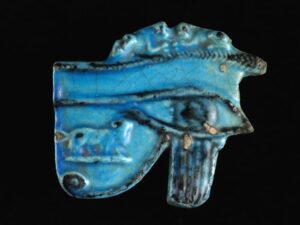
© Trustees of the British Museum.
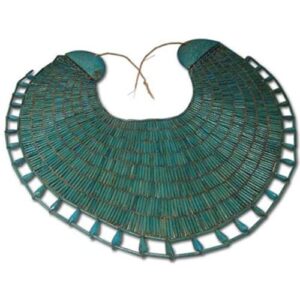
This long period saw a huge development in Egyptian culture. Strong leadership by Pharaohs resulted in mind-boggling achievements like the Great Pyramid of Giza. Single-string necklaces made a place for the typical broad wesekh, an item that would remain popular until the end of the Egyptian classical period. Several strands of colorful beads were strung and held apart by (golden) spacer beads. By this time anklets, diadems, girdles, bangles, and bracelets were all in use.
Amongst the materials used to create jewelry were now the highly prized silver and electrum. Possibly because of its rarity, silver was regarded as being more valuable than gold by the Egyptians. Another new material was Egyptian blue, a pigment used throughout Egyptian history to mimic the color of turquoise. Glazed materials became even more common and beads and amulets made of gold became bigger and more abundant.
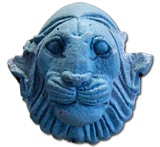
The period between 2181 – 2040 BC was marked by civil war, famine and general disruption of society and would lead to the expectation that jewelry would be virtually absent or at least of inferior materials but some fine pieces have come from this time.
Middle Kingdom 2040-1730 BC
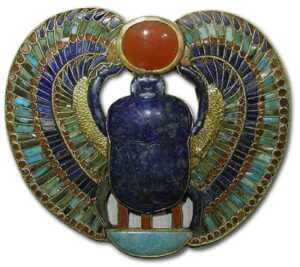
Putting an end to the social turbulence of the first intermediate period, the dynasties of the Middle Kingdom also saw the height of the gold working techniques in ancient Egypt. À jour openwork, chasing, repoussé, inlaying in cloissons and granulation, were all techniques used to manufacture the unique jewelry of the Middle Kingdom. The use of silver increased and wall paintings in tombs from this period show jewelry workshops with bead makers and goldsmiths sitting side by side. One of the products made by these workshops would have been gold-capped beads.
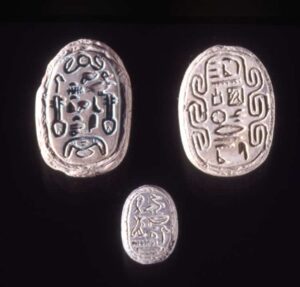
© Trustees of the British Museum.
Around 2000 BC finger rings start to appear. Stone scarab beetles and other motifs carved on one side with seals carved on the reverse acted as signet rings. Gold wire was wrapped around the shank of the ring and then through a hole in the seal so that it could swivel. The item would have been worn with the seal on the inside and flipped around when necessary. Later, solid gold rings are also produced.
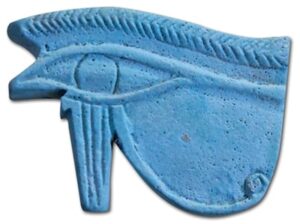
Louvre.
Colorful gemstones in combination with finely worked gold decorated the plain white linen clothing of the Egyptians. Favorite motifs were the scarab and the eye of Horus but the use of cobras and vultures was reserved for the Pharaoh himself. The symbolism that we encounter in all these motifs, as well as the color used, are significant. Red stood for blood and therefore depicted life and energy, green stood for new growth and resurrection and blue for the sky. Protective amulets are worn side by side with status symbols. It wasn’t just the wealthy who wore jewelry, poorer people have been found buried with simple necklaces, showing that self-adornment and shielding from mishap occurred in all layers of society. This period ended in yet another period of general disruption, an era historians call the Second Intermediate Period and runs from 1786 – 1567 BC.
New Kingdom 1567-1085 BC
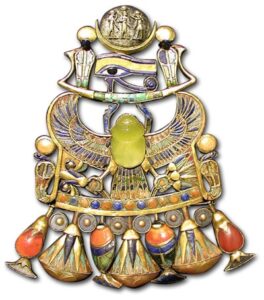
Jewelry from the New Kingdom overall resembles that of the Middle Kingdom. A few new things are worth noting: colored glass is produced in far bigger quantities and becomes a common substitute for colored stone beads and inlay. A second innovation is the introduction of the earring and earplug around 1600 BC which were first worn only by women but within 200 both sexes were wearing them. Ribbed bands formed by several hoops of gold soldered together were popular as well as glass and faience earplugs, some of which required an enlarged hole in the lobe.
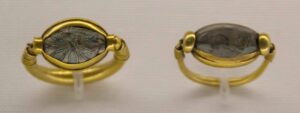
This item is displayed in the Schmuckmuseum in Pforzheim, Germany.
As the previously discussed periods, this one ends in a period of disruption as well. Egypt would emerge from this third intermediate period during the 8th century BC. From that time on Egypt has been under the influence of the Persians, Greeks and later Romans. Emeralds were found in Egypt somewhere after the 8th century BC and were used in Etruscan and Roman jewelry.
Sources
- 7000 Years of Jewellery, Various Authors, edited by Hugh Tait, British Museum Press, London, 1986.
- Ancient Jewellery: Interpreting the Past, Ogden, Jack, British Museum Press, London, 1992.
- Jewelry, from Antiquity to the Present, Phillips, Clare, Thames & Hudson, London, 1996.